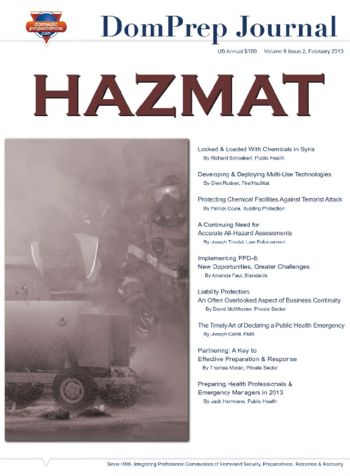

Implementing PPD-8: New Opportunities, Greater Challenges
Amanda Faul
February 26, 2013
Improving national resilience is a process that requires developing and promulgating new policies, defining missions and capabilities, and implementing change through training and education. As the two-year anniversary of Presidential Policy Directive 8 approaches, policy makers and responders are learning much more about the planning opportunities, and new challenges, they are likely to encounter in the years to come.

Liability Protection: An Often Overlooked Aspect of Business Continuity
David McWhorter
February 20, 2013
Makers and users of anti-terrorism products and services have more to fear than terrorism itself. After certain technologies have changed hands, the sellers and consumers alike may face future liabilities that would halt further production and/or the continuation of services. To guard against that problem, the U.S. Department of Homeland Security offers a unique program that can limit the liability companies may face.

Incident Command System: Perishable If Not Practiced
Stephen Grainer
February 17, 2013
Although the basic Incident Command System (ICS) is taught across emergency response disciplines, several shortcomings and constraints could lead to its downfall. Training for ICS is not a one-time occurrence, but should be an ongoing process of expanding knowledge, exercising skills, and passing on these abilities for the benefit of future generations.

Preparing Health Professionals & Emergency Managers in 2013
Jack Herrmann
February 13, 2013
National Security Special Events such as the presidential inauguration require dozens of committees working closely together to coordinate efforts to protect the health and security of all visitors and participants. Stationary and mobile medical units were strategically positioned to address any health concern that might arise.

Locked & Loaded in Syria
Richard Schoeberl
February 13, 2013
The Chemical Weapons Convention prohibits “the development, production, acquisition, stockpiling, retention, transfer or use of chemical weapons by States Parties.” However, when a nation refuses to sign the agreement and continues to stockpile chemical warfare agents, it raises worldwide concerns. In the case of Syria, its own citizens have good reason to fear being the target of attack.

Partnering: A Key to Effective Preparation & Response
Thomas (Tom) Moran
February 12, 2013
Super Storm Sandy caused major power outages and service interruptions throughout many communities in New Jersey and New York. Thanks in part to the assistance provided by previously established partnerships of the All Hazards Consortium, the public and private sectors were better able to coordinate the services and efforts needed to expedite the recovery process.

The Timely Art of Declaring a Public Health Emergency
Joseph Cahill
February 6, 2013
Swine flu, bird flu, and pandemic flu have been widely publicized by the news media over the past decade. Public health and emergency management officials walk a tight line, though, between the risk, on the one hand, of sounding an alarm prematurely and, on the other, of missing the pivotal moment when a warning will do the most good. When officials do sound the alarm and the prospective hazard either fizzles out or turns out to be less severe than anticipated, they are often portrayed as crying wolf – even if the reduced severity is because of their own hard work in mitigating the danger.

Protecting Chemical Facilities Against Terrorist Attack
Patrick Coyle
February 6, 2013
The U.S. government’s chemical security program helps to identify high-risk targets for terrorist attacks based on the type of chemical being manufactured or delivered and the physical location of the facility where it is stored.

The Local Imperative for Building and Sustaining National Resilience
Marko Bourne
January 30, 2013
Joplin High School and Sandy Hook Elementary School both suffered devastating disasters – one natural and one manmade. In both cases, the residents rallied behind their schools and their communities to rebuild and recover. Lesson learned: From unexpected events, unexpected leaders often emerge who are both willing and able to lead their communities back to some form of “normal.”

FINAL REPORT: Planned Special Events
H. Steven Blum
January 29, 2013
When 10,000 or more people gather for a planned special event, there are many things to consider: risks, credentialing, volunteers, standards, training, transportation, and communication. This report addresses each of these topics from the perspectives of practitioners who share their experience with large-scale events.

